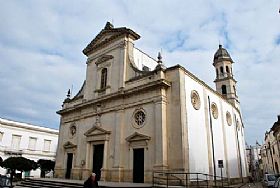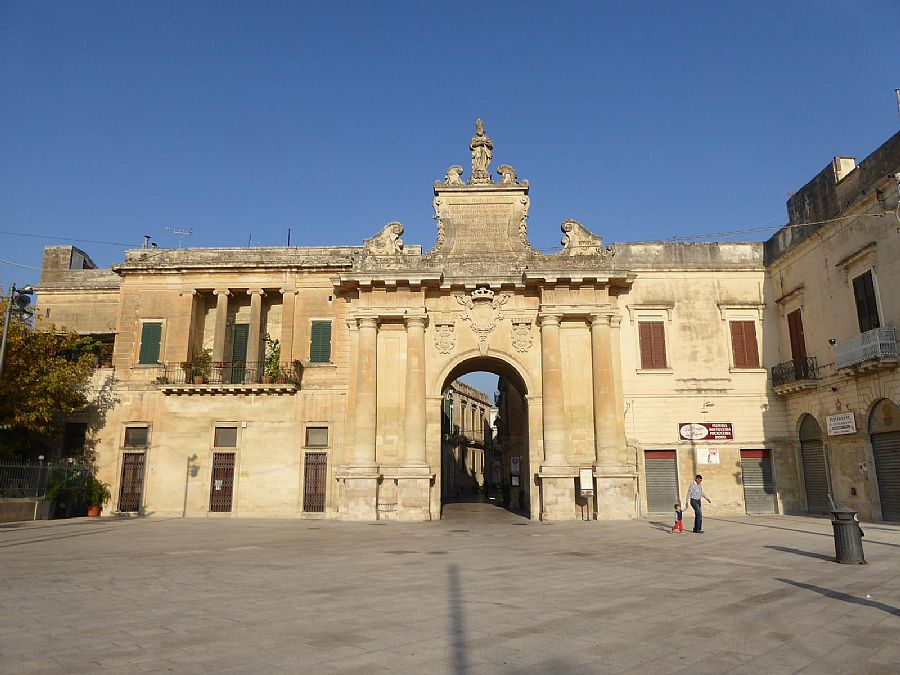Soleto

Sitting in the middle of the sunny Salento of Puglia, Soleto has roots going back many millennia. The town is one of several in the area that still speaks an ancient dialect called Griko, an infusion of Italic-Greek that has been retained through the centuries, in this area known as Grecia Salentina.
It was inhabited in the neolithic age and was a center of bronze manufacture, with examples on display in the archeological museum in Taranto. The ancient Messapic people already had an established community when the Greeks and Romans arrived. The Roman name given to the town was Soletum, which may derive from "sole" (sun) or from a Latin or Greek term meaning "solitary place". Soleto was an important crossroads between the Adriatic and Ionian seas and between the tip of Puglia and the northern zone. It was once enclosed in a 3-kilometer perimiter wall.
A few of the sights you won't want to miss:
Church of Santo Stefano contains a vivid display that is practically unkown outside the area - a stunning fresco of the Last Judgement, like a Byzantine version of Michelangelo's famous rendition. The facade bears traces of Romanesque, Moorish and Byzantine styles, in Lecce stone. It's easy to walk right by thinking it is a simple, unadorned church, but inside are frescoes that will drop your jaw. Some have deteriorated, but those that remain are stunning, showing the Holy Trinity, the Life of Christ, the Apostles, and of course the martydom of St. Stephen (stoning). The back wall bears a full frescoing of the Last Judgement, so worshippers would leave with those thoughts and images to retain.
Chiesa a Guglia. The church is Santa Maria Assunta, but it's actually not the church itself that's the attraction but the tall tower adjoining it. Called a guglia, the towering 40 meter high column, often called the Guglia da Raimondo, was built by Duke Raimondo Orsini del Balzo, not just as a display of power but as a legacy-landmark over his domain, mid-way between the Adriatic and Ionian Seas. Decorative designs adorn it and the small cupola has maiolica tiles.
Madonna delle Grazie. A church built in restrained Baroque style (compared to the riotous Puglia norm) it contains a "miraculous fresco" of the Madonna and Child, taken from a roadside shrine. Legend says that one day as farmers returned to town from the fields they stopped at the shrine and the face of Mary was suddenly obscured by a dark veil, that has never been able to be removed.
Porta San Vito. The last survivor of the ancient gateways to the town, this one is a lovely way to "cross the threshold" and enter Solet's old town.
Enjoy the comfort of a home rental in Puglia.

 Amalfi Coast
Amalfi Coast Sorrento Coast
Sorrento Coast Tuscany
Tuscany Cilento National Park
Cilento National Park Lake Como
Lake Como Rome and Latium
Rome and Latium Umbria
Umbria Capri and Ischia
Capri and Ischia Venice
Venice Puglia (Apulia)
Puglia (Apulia) Liguria
Liguria Sicily
Sicily Lake Maggiore
Lake Maggiore Lombardy
Lombardy Sardinia
Sardinia Lake Garda
Lake Garda Abruzzo and Marche
Abruzzo and Marche Calabria
Calabria

